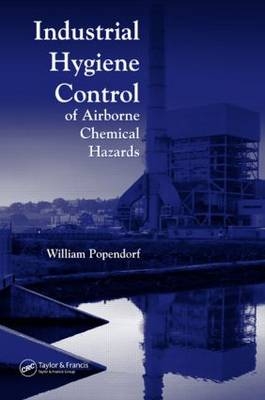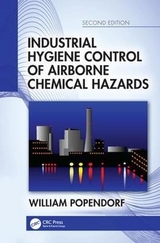
Industrial Hygiene Control of Airborne Chemical Hazards
Crc Press Inc (Verlag)
978-0-8493-9528-4 (ISBN)
- Titel erscheint in neuer Auflage
- Artikel merken
Do you need guidelines for choosing a substitute organic solvent that is safer to use? Do you need an effective, cheap but perhaps temporary way to reduce exposures before you can convince your employer to spend money on a long-term or more reliable solution? Do you need information about local exhaust ventilation or personal protective equipment like respirators and gloves?
Industrial Hygiene Control of Airborne Chemical Hazards provides the answers to these questions and more. Science-based and quantitative, the book introduces methods for controlling exposures in diverse settings, focusing squarely on airborne chemical hazards. It bridges the gap between existing knowledge of physical principles and their modern application with a wealth of recommendations, techniques, and tools accumulated by generations of IH practitioners to control chemical hazards.
Provides a unique, comprehensive tool for facing the challenges of controlling chemical hazards in the workplace.
Although William Popendorf has written the book at a fundamental level, he assumes the reader has some experience in science and math, as well as in manufacturing or other work settings with chemical hazards, but is inexperienced in the selection, design, implementation, or management of chemical exposure control systems. Where the book is quantitative, of course there are lots of formulae, but in general the author avoids vague notation and long derivations.
AN INTRODUCTION TO INDUSTRIAL HYGIENE CHEMICAL HAZARD CONTROL
An Overview of Industrial Hygiene
The Spatial Spectrum of Exposure Scenarios
The IH Paradigm of Control Priorities
The Approach, Organization, and Philosophy of this Book
BASIC GAS AND VAPOR BEHAVIOR
Gas and Vapor Definitions
Vapor Pressure Changes with Liquid Temperature
IH Uses of Dalton's Law
IH Uses of the Ideal Gas Law
The Effects of T and P on Airborne Concentration
The Effects of T and MW on Plume Density
Dense Vapors
BASIC AEROSOL BEHAVIOR
How Aerosols Differ from Gases and Vapors
Aerosol Definitions
Particle Diameter Distributions
Modeling Particle Behavior
Stokes and Aerodynamic Diameters
Aerosol Diameters and Human Health
CHEMICAL EXPOSURE CONTROL CRITERIA
Performance and Specification Standards
Health Criteria for Chemical Control
Safety Criteria for Chemical Control
The Oxygen Deficiency Criterion
Comparisons among Criteria
OSHA Ventilation Standards
Open-Surface Tanks
Appendix
VAPOR GENERATION AND BEHAVIOR
Mechanisms of Vapor Generation
Mechanisms of Plume Dispersion
Four Universal Airborne Chemical Exposure Scenarios
Four Settings with Vapor Accumulation
Vapors from Incomplete Evaporation with No Ventilation
Vapors from Complete Evaporation with No Ventilation
Differentiating between Complete from Incomplete Evaporation
Vapors from Continuous Evaporation with Ventilation
VAPOR PRESSURE IN MIXTURES
Mixtures
Defining Liquid Mixtures
Raoult's Law for Ideal Liquid Mixtures
The Need for an Empirical Adjustment to Raoult's Law
Methods to Predict an Empirical Adjustment to Raoult's Law
Examples of Mixtures
Henry's Law
Measuring Mixtures Experimentally
Applying Predictive Methods to Mixtures
CHANGING THE WORKPLACE
The Technologic Dimension of Change
The Psychologic Dimension of Change
The Economic Dimension of Change
Implementing the IH Control Paradigm
SOURCE CONTROL VIA SUBSTITUTION
Alternative Technologies
Volatility and Alternative Chemicals
Aqueous Solvents
Semiaqueous Solvents
Organic Solvents
Toxicity versus Volatility
The Vapor Hazard Ratio
Using VHR and Other Indices in Risk Management
OTHER SOURCE AND NONVENTILATION PATHWAY CONTROLS
Concepts
Some Nonvolatile Chemical Source Controls
Some Volatile Chemical Source Controls
Effects of Modifying Volatile Chemical Source Variables
Work Practices as an Exposure Control
Automation as an Exposure Control
Separation as an Exposure Control
Isolation as an Exposure Control
Fundamental Nonventilation Control Equations
AN OVERVIEW OF LOCAL EXHAUST VENTILATION
Local Exhaust Ventilation Definitions
Principles of Local Exhaust Ventilation
The LEV Design Sequence
VENTILATION FLOW RATES AND PRESSURES
Applying Conservation of Mass to Ventilation
Applying Conservation of Energy to Ventilation
Static Pressures (P and SP)
Velocity Pressure
Total Pressure and Pressure Losses
Compilation of the Fundamental Ventilation Control Equations
Appendix
MEASURING VENTILATION FLOW RATES
Qualitative Air Flow Indicators
Air Velocity and Manometers
Aerodynamic Velocity Meters
Thermodynamic Velocity Meters
The Boundary Layer
Assessing Flow in Ducts
Calibrating Anemometers
DESIGNING AND SELECTING LOCAL EXHAUST HOODS
Local Exhaust Hood Design Principles
Selecting a Control Velocity
Using the DallaValle Equation
Designing a Slotted Collection Hood
Designing a Hood Using an ACGIH "VS" Diagram
Designing a Hood for an Open Surface Tank
Designing a Canopy Hood over an Isothermal Source
Designing a Canopy Hood over a Hot Source
Designing a Push-Pull Hood System
Using an Air Shower
Using Commercial and Other Specialty Hoods
PREDICTING PRESSURE LOSSES IN VENTILATION SYSTEMS
A Primer on Energy and Pressure Losses
Energy Losses from Hood or Duct Entry
Selecting a Duct Velocity
Selecting the Duct Size and Material
Energy Losses from Friction in Straight Ducts
An Example of Hood Entry and Duct Friction Losses
Turbulence in Duct Fittings
Losses from Elbows
Losses from Duct Contractions
Losses from Duct Expansions
Comparing Contraction and Expansion Losses
Energy Losses in Branched Duct Systems
The LEV Design Worksheet
EXHAUST AIR CLEANERS AND STACKS
Air Cleaning Needs and Options
Air Cleaner Selection Criteria
Particulate Aerosol Collectors
Aerosol and Gas Collectors
Gas and Vapor Collectors
Exhaust Stacks and Reentrainment
VENTILATION FANS
Fans have Two Pressures
Fan Performance
Matching Fan Performance to System Requirements
Some Air Mover Terminology
Axial Fans
Centrifugal Fans
The Fan Laws
Fan Selection and Installation
VENTILATION OPERATING COSTS
Fan Efficiency and Power Consumption
Electricity Costs for Fans
Make-Up Air
Heating Costs for Make-Up Air
Cooling Costs for Make-Up Air
Energy Conservation
LEV SYSTEM MANAGEMENT
Why Monitor System Performance
When to Monitor System Performance
Where, What, and How to Monitor System Performance
LEV Troubleshooting
Postinstallation LEV Adjustments
Appendix
GENERAL VENTILATION AND TRANSIENT CONDITIONS
General Ventilation and Chemical Control
Components of the Dilution Ventilation Model
The General Solution to the Dilution Ventilation Model
Concentrations during a Transient Increase
Concentrations during a Transient Decrease
Accumulation with No Ventilation
GENERAL VENTILATION IN STEADY STATE CONDITIONS
The Concentration in Steady State Conditions
Normal Building Ventilation Requirements
Methods to Estimate a Contaminant Generation Rate
General Ventilation (HVAC) Systems
Controlling Exposures Via Dilution Ventilation
Sources of HVAC and Indoor Air Quality Problems
ADMINISTRATIVE CONTROLS AND CHEMICAL PERSONAL PROTECTIVE EQUIPMENT
Administrative Controls
Personal Protective Equipment
Basic PPE Program Management
Terms and Concepts Regarding Chemical PPE
Recognizing Dermal Hazards
Chemical Protective Gloves
Chemical Protective Clothing
Levels of PPE Ensembles
Appendix
RESPIRATOR CONTROLS
Respirator Terms and Concepts
Different Kinds of Protection Factors
Variables Affecting Protection Factors
Respirator Fit and Seal Testing
Respiratory Protection Program Requirements
A Respirator Selection Protocol
Appendices
APPENDICES
Index
| Erscheint lt. Verlag | 15.5.2006 |
|---|---|
| Zusatzinfo | 335 equations; 39 Halftones, black and white; 75 Tables, black and white; 298 Illustrations, black and white |
| Verlagsort | Bosa Roca |
| Sprache | englisch |
| Maße | 178 x 254 mm |
| Gewicht | 1429 g |
| Themenwelt | Naturwissenschaften ► Chemie ► Technische Chemie |
| Technik | |
| ISBN-10 | 0-8493-9528-3 / 0849395283 |
| ISBN-13 | 978-0-8493-9528-4 / 9780849395284 |
| Zustand | Neuware |
| Informationen gemäß Produktsicherheitsverordnung (GPSR) | |
| Haben Sie eine Frage zum Produkt? |
aus dem Bereich



